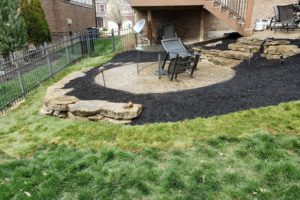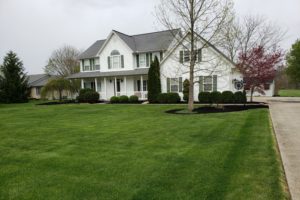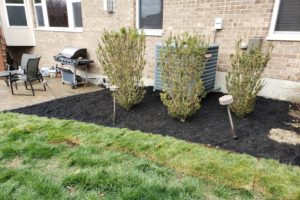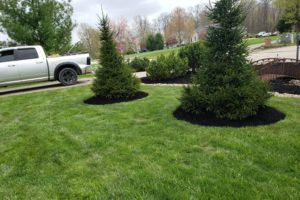
Mulch help plants and vegetation thrive, it also prevents pesky weeds from taking over. Mulch isn’t anything fancy, in fact it usually consists of a simple material, that when placed on top of soil will provide you with healthier plants that are easier to maintain. There are plenty of benefits when it comes to using mulch and these benefits are not limited to just a handful of plants, they apply to almost all. Use mulch on your flower beds, gardens, bases of trees, and for filling vacant spaces.
The Benefits of Using Mulch
- Reduces the Growth of Weeds – Aside from being an eye sore, weeds can take away vital nutrients and water from other plants. Mulch prevents weeds from growing which helps other plants thrive.
- Keeps Your Soil Moist – Mulch can help your garden retain water so that you won’t have to water it as frequently.
- Helps Maintain Soil Temperature – Soil can become too hot or too cold as the climate changes from season to season. Mulch helps the soil maintain its temperature allowing your plants to survive change.
- Prevents Soil Erosion – Mulch keeps soil from becoming compacted. Heavy rains can lead to erosion or cause the soil to become densely compacted.
- Keeps Dirt From Getting on Everything – Prevents dirt from getting on your flowers, fruits, and vegetables. This helps prevent plant diseases as well as makes washing your fruits and vegetables easier.
- Makes your garden look great!
Organic Mulch
If you want to minimize weed growth, retain moisture, and have a garden that looks good, the following types of mulch will probably be best.
- Wood or bark chips are the most frequently used by gardeners worldwide. Wood and bark chips are typically made from woods like cedar or pine so not only do they look good, but they smell good too! If you’re thinking about mulching a pathway or an area with an incline, we advise using shredded wood or bark mulch. While shredded mulch does decompose faster, it will not wash away as easily during periods of heavy rain.
- Compost or shredded leaves are another common choice among gardeners and you can usually find them right in your yard. It is important to check your compost for mold; you should also avoid using materials that have been treated with pesticides as it will eventually deep into the soil and can harm your plants.
You can purchase bark and wood chips in bags or bulk at gardening centers and hardware stores. Compost and shredded may also be purchased but if you’re looking to save money, you can use leaves or homemade compost from your own yard. Mulch pieces come in a variety of sizes. Small, fine pieces are easier to install in close-set, small areas like flower beds. Large, coarse pieces are a good option for large spaces or around bigger plants such as trees and oversized shrubs. Coarse mulch will last longer than fine mulch and will allow more water, air, and other nutrients reach the soil. However, it is important to remember that these pieces will wash away easier in the event of heavy rain. Finer mulch is a good option for walkways and places that you won’t be growing plants as they do not allow as much water or air to reach the soil.
Other Organic Options
Wood or bark chips, compost, and shredded leaves are the most commonly used types of organic mulch, there are a few more options you can choose from.
- Straw or hay are a good choice for vegetable gardens but one downfall is that hay can introduce weeds.
- Pine needles work best with plants that thrive in high-acidity soil such as blueberries and rhododendrons.
- Cocoa bean hulls look and smell good, however they contain a chemical that is extremely toxic to some animals, including cats and dogs. If you are a pet owner, consider a different type of mulch for your garden.
Inorganic Mulch
Inorganic mulch will not improve soil quality like organic mulch does but they are a good option for certain gardens and purposes.
- Plastic Sheeting works to keep your soil moist and warm. This is a good choice for vegetable gardens.
- Rocks can add a decorative look and are suitable for gardens in arid, desert like climates.
- Rubber chips last longer than wood or bark chips. While you can use these in your garden or flower beds, they are a great choice for underneath playgrounds or swing sets as they provide cushion should your child fall.
Inorganic mulches can be hard to remove after you install them, so if you’re uncertain or like to change things up often, these might not be the best option for you.
Mulching Your Flower Beds
Before mulching, you should mow and remove weeds. Next, water the soil thoroughly. After you prepped the area for mulch, use your wheelbarrow to transport a bag or pile of mulch to the area. Dump it out then use your shovel or hands to spread it around the entire area. Use your hand rake or hoe to make sure that the mulch is even. For flower beds, a two inch layer is enough to prevent weeds from growing while helping your flowers thrive. Leave several inches around the base of the flowers or plants free of mulch to avoid mold and disease. Organic mulch should be installed in later spring once the ground has started to warm up, or at the end of autumn, before the first freeze but after a heavy rainstorm. You can re-apply mulch during the summer, if necessary. If you are thinking about mulching your vegetable garden, wait until the ground has begun to warm up— this will optimize seed germination and plant growth.
Using Mulch as Weed Control
Laying mulch over weeds is a great way to prevent weed growth. There are several ways you can do it! As previously mentioned, hay is not a good choice for weed control and rocks are not an effective weed barrier when used alone. However, there are still quite a few options that will protect your flower beds and garden against weeds like bark and wood chips, compost, newspapers, cardboard, and plastic sheeting. Just as you would do in your flower bed, you should mow, pull weeds, then water before you install weed-barrier mulch. One great choice to kill weeds or grass is corrugated cardboard or many layers of newspaper to create a surface that will not allow sunlight to pass through. Water the newspaper or cardboard thoroughly after you’ve laid it on the soil so that the wind won’t blow it away. Once you’ve covered the entire area, lay several inches of mulching on top. By using the cardboard or newspaper method, you will not have stress about the plants you are hoping to keep healthy. Water can still soak through these materials enough to keep the soil beneath it damp. You should still leave a decent perimeter of space around the base of those plants. This allows water to get to the roots of the plant. Use only black and white ink newsprint— no color ink as color ink can become toxic to the plants as it is soaked into the soil.
Mulching Around Trees
By mulching around the base of your trees, you can help keep their roots healthy. Healthy roots grow healthy trunks which in turn grow healthy canopies. Mulch helps soil retain moisture and allows it to maintain its temperature; this keeps the roots from getting too cold during freezing temperatures and too warm in the heat of the summer. Organic mulch supplies your trees with nutrients as it decays. You can apply mulch thicker around trees versus in flower beds— between three and four inches is plenty. Spread it out evenly in a circle around the base of the tree to avoid bark decay. Once the mulch has decreased by half, you should add new mulch. Depending on which mulch you used, this could take many months or even a year.
Keep Your Yard Looking Great All Year
Mulching is a simple and affordable way to keep your yard looking great. It offers many benefits to your yard, garden, and soil. There are quite a few home owners that do not have time to conquer mulching. Some lack the mobility or suffer from health issues that restrict their ability to take on such task.
Contact us (513) 550-7782 for more information -or- to setup an free consultation!
—
 About D2 Landscaping & Outdoor
About D2 Landscaping & Outdoor
D2 Landscaping is one of the fastest-growing landscaping company in the Cincinnati/Northern Kentucky area. We are a local and family-owned landscaping company offering a variety of landscape services, from new installations and complete renovations, to simple improvements. Whether you want to add a few trees and shrubs to compliment your existing landscape, or a complete makeover with outdoor living areas, our team can transform your outdoor dreams into reality. We pride ourselves in offering timely and professional services with highly trained personnel. We use superior advanced products along with precise installation techniques to guarantee your perfect vision. Our high level of standards continue to produce the best quality product resulting in glowing client testimonials, referrals, and customer loyalty.
>> Learn More





